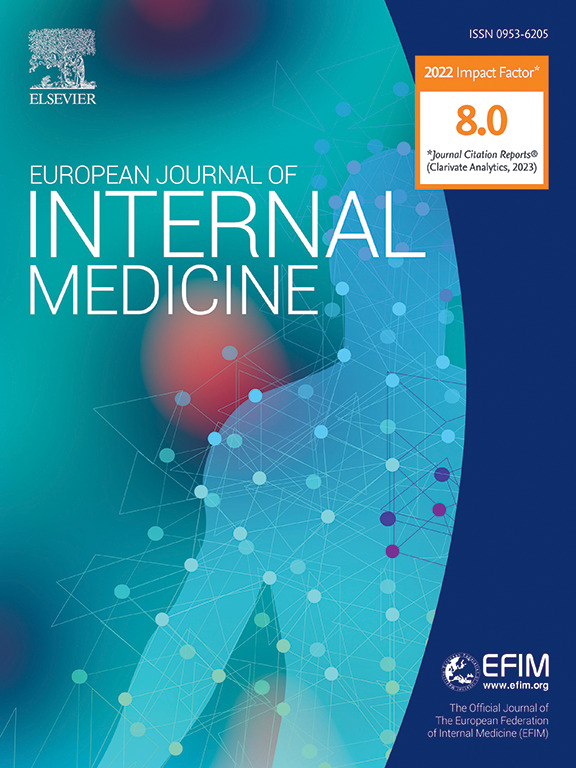The clinical relevance of the reversal of coronary atherosclerotic plaque
IF 6.1
2区 医学
Q1 MEDICINE, GENERAL & INTERNAL
引用次数: 0
Abstract
Atherosclerotic cardiovascular disease (ASCVD) remains a leading cause of death globally despite advances in preventive therapies. Understanding of the initiation and progression of atherosclerosis, the interplay between lipoproteins, endothelial dysfunction, inflammation, and immune responses is critical to treating this disease. The development of vulnerable coronary plaques prone to thrombosis, can lead to acute coronary syndromes, for these reasons, the potential plaque stabilization and regression through pharmacological interventions, particularly lipid-lowering agents like statins and PCSK9 inhibitors is crucial. The imaging techniques such as intravascular ultrasound (IVUS), near-infrared spectroscopy (NIRS), and optical coherence tomography (OCT) play a key role in assessing plaque composition and guiding interventional therapeutic strategies. Clinical evidence supports the efficacy of intensive lipid-lowering therapy in inducing plaque regression, with studies demonstrating reductions in plaque volume and improvements in plaque morphology assessed by IVUS, OCT and NIRS.
While pharmacological interventions show promise in promoting plaque regression and stabilization, their impact on long-term cardiovascular events requires further investigation. Multimodality imaging and comprehensive outcome trials are proposed as essential tools for elucidating the relationship between plaque modification and clinical benefit in coronary atherosclerosis. The stabilization or regression of atherosclerotic plaque might serve as the phenomenon linking the reduction in LDL-C levels to the decrease in cardiovascular events. Overall, this review emphasizes the ongoing efforts to advance our understanding of ASCVD pathophysiology and optimize therapeutic approaches for improving patient outcomes.

冠状动脉粥样硬化斑块逆转的临床意义。
尽管预防性疗法取得了进展,但动脉粥样硬化性心血管疾病(ASCVD)仍然是全球死亡的主要原因。了解动脉粥样硬化的发生和发展过程,以及脂蛋白、内皮功能障碍、炎症和免疫反应之间的相互作用,对于治疗这种疾病至关重要。易形成血栓的脆弱冠状动脉斑块可导致急性冠状动脉综合征,因此,通过药物干预,特别是他汀类药物和 PCSK9 抑制剂等降脂药物,稳定和消退斑块至关重要。血管内超声(IVUS)、近红外光谱(NIRS)和光学相干断层扫描(OCT)等成像技术在评估斑块组成和指导介入治疗策略方面发挥着关键作用。临床证据支持强化降脂疗法在诱导斑块消退方面的疗效,研究表明斑块体积缩小,斑块形态也有所改善,这些都是通过 IVUS、OCT 和 NIRS 评估得出的结果。虽然药物干预有望促进斑块消退和稳定,但其对长期心血管事件的影响还需要进一步研究。多模态成像和综合结果试验被认为是阐明斑块改变与冠状动脉粥样硬化临床获益之间关系的重要工具。动脉粥样硬化斑块的稳定或消退可能是低密度脂蛋白胆固醇水平降低与心血管事件减少之间的关联现象。总之,这篇综述强调了我们正在努力推进对 ASCVD 病理生理学的了解,并优化治疗方法以改善患者预后。
本文章由计算机程序翻译,如有差异,请以英文原文为准。
求助全文
约1分钟内获得全文
求助全文
来源期刊
CiteScore
9.60
自引率
6.20%
发文量
364
审稿时长
20 days
期刊介绍:
The European Journal of Internal Medicine serves as the official journal of the European Federation of Internal Medicine and is the primary scientific reference for European academic and non-academic internists. It is dedicated to advancing science and practice in internal medicine across Europe. The journal publishes original articles, editorials, reviews, internal medicine flashcards, and other relevant information in the field. Both translational medicine and clinical studies are emphasized. EJIM aspires to be a leading platform for excellent clinical studies, with a focus on enhancing the quality of healthcare in European hospitals.

 求助内容:
求助内容: 应助结果提醒方式:
应助结果提醒方式:


